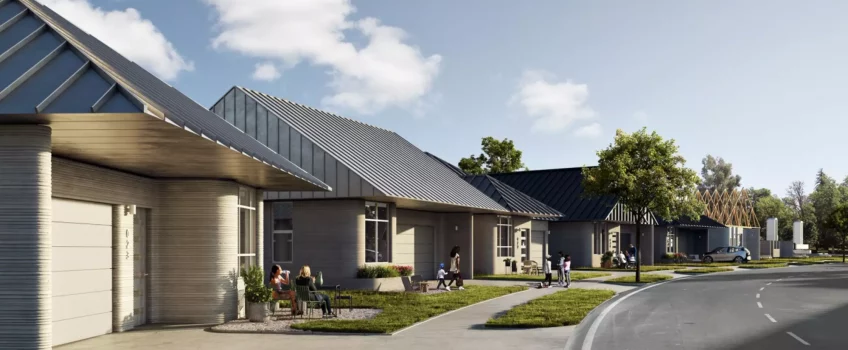
As precision engineering and fabrication specialists, we work across various sectors and that includes construction. As such, we keep our fingers on the pulse of any new developments and few are as exciting as 3D-printed homes. Previously considered a method for product prototyping, 3D printing has changed drastically in the last few years extending to building homes around the world and on Mars. Now, ICON and Lennar are building the biggest ever neighbourhood consisting of 3D-printed homes.
Constructing 3D-Printed Homes
ICON, a construction technologies company pioneering large-scale 3D printing is collaborating with Lennar which is one of America’s leading homebuilders to develop a neighbourhood of 3D-printed homes. They will use ICON’s innovative robotics, software and advanced materials and will be co-designed by the architecture firm, BIG-Bjarke Ingels Group. According to reports, the 100-home community will break ground in 2022.
The build process will be similar to other 3D-printed construction projects we’ve written about and will involve ICON’s own Vulcan model 3D printer. This system will extrude a cement-like mixture in layers to build up the basic structure of each home. Once the shell is built, human builders will put on the finishing touches such as adding a roof, doors, windows, interior features and furniture.
According to ICON: “Designed as a diverse collection of contemporary living spaces, the homes take on a variety of distinctive spatial concepts. The design approach modernises the aesthetic of the suburban home, while the 3D-printing technology texturizes and provides distinctive touchpoints for each space.”
ICON’s Leading 3D Printing Technology
Becoming a leader in the construction of 3D-printed homes is no easy feat as ICON has spent years on research and development. Their efforts paid off with 3D printing technology that can produce more resilient and energy-efficient homes faster than conventional construction methods. It also results in less waste and keeps construction projects on schedule and on budget while giving more design freedom.
ICON’s Vulcan construction system was designed and engineered specifically with volume 3D printing of homes with extreme precision and speed. It can produce 3D-printed homes and structures up to 3,000 sq ft built to the International Building Code (IBC) structural code standard. They claim it can also last as long or longer than standard Concrete Masonry Unit (CMU) built homes.
ICON’s proprietary wall system and advanced materials are stronger and more durable than traditional building materials. These 3D-printed homes are designed to be safer and more resilient; capable to withstand extreme weather which greatly reduces the impact of natural disasters. An added benefit is that they can be printed at high speeds and at scale.
3D-Printed Homes Could Revolutionise The Built Environment
According to ICON co-founder and CEO Jason Ballard: “Construction-scale 3D printing not only delivers higher-quality homes faster and more affordably, but fleets of printers can change the way entire communities are built for the better. The United States faces a deficit of approximately 5 million new homes, so there is a profound need to swiftly increase supply without compromising quality, beauty, or sustainability and that is exactly the strength of our technology.”
Martin Voelkle, Partner, BIG-Bjarke Ingels Group believes that “additive manufacturing has the potential to revolutionise the built environment as it gets adopted by the industry at scale. By partnering with ICON and Lennar, we are able to see this new technology roll out to the widest possible audience. The 3D-printed architecture and the photovoltaic roofs are innovations that are significant steps towards reducing waste in the construction process, as well as towards making our homes more resilient, sustainable, and energy self-sufficient.”
Recommended: 3D Printing In Construction: Building A House In A Day
A Brief Look At The History Of 3D Printing
3D printing dates back to the mid-1980s when stereolithography (SLA) was conceived which worked as a high-powered laser turning a liquid resin into a solid material. It is an additive technology that creates a product from the ground up layer-by-layer.
While SLA is still one of the most popular 3D printing technologies today, any technology that creates parts in an additive fashion is considered 3D printing. Other popular additive technologies include selective laser sintering (SLS), fused deposition modelling (FDM) and direct metal deposition (DMD).
Before the adoption of building information modelling (BIM), even architectural firms used 3D printing to build scale models. It didn’t take too long before this technology was used for more ambitious construction projects.
3D Printing Projects Over The Years
3D printing technology has been used for more than a decade with many fascinating projects, including the latest 3D-printed homes in Texas. Here are just a few of many noteworthy developments:
- In 2004, a USC professor tried to 3D print a wall which is widely accepted as the first attempt to introduce the technology into construction
- In 2014, a full canal house was built using 3D printing in Amsterdam
- A 3D-printed mansion was completed in China in 2016
- Another development in 2016 was the Dubai Future Foundation who built its Office of the Future using 3D printing
- 3D-printed homes in Germany were awarded the “German Innovation Award” in 2021
Conclusion
Today, 3D printers are capable of printing walls and processing cement with the potential to reshape construction as we know it. The question is whether 3D-printed homes are a fleeting trend or will it become a long-term solution. The companies involved in this project seem to think so as they had this to say:
“It is an honour and a huge milestone for ICON to partner with Lennar, an elite top-tier homebuilder with a commitment to innovation. We believe this will be a watershed moment in the history of community-scale development and the future breaking into the present.”
For more interesting articles on construction, fabrication, advanced manufacturing and precision engineering, please follow our blog. You can also find us on social media or get in touch with our team of experts if you require assistance with your project.


 Mail:
Mail: 



